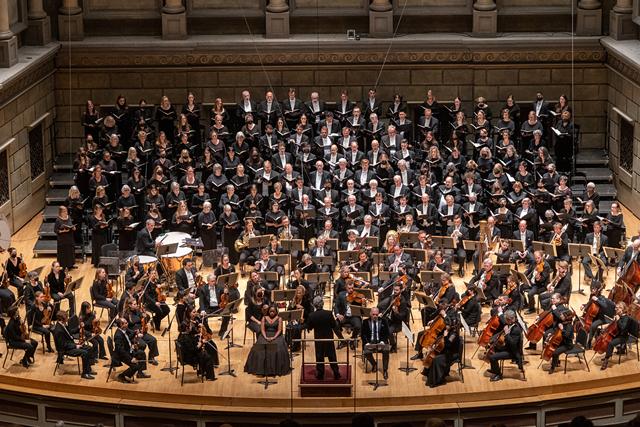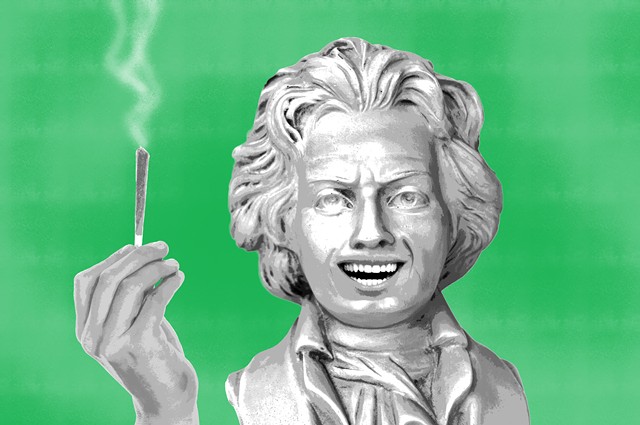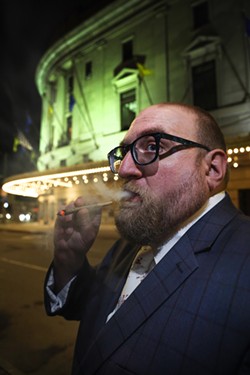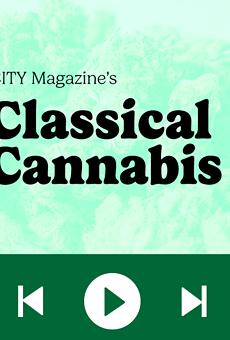
- PHOTO BY MAX SCHULTE
- CITY Arts Editor Daniel J. Kushner smokes an Island Kush joint outside Eastman Theatre's Kodak Hall.
But that night was going to be different. The Island Kush joint in my suit jacket pocket guaranteed it. The strain was a hybrid whose name was altogether appropriate: Kush was my nickname growing up, and now I was living up to the moniker.
I even coined some classical music-nerd euphemisms for sparking up: I smoked some Verdi. I wrote the Drag in C. I indulged in the Rite of Spring. You get the idea — I got high.
Then I walked into Kodak Hall, took my $72 plush red velvet seat, and settled in for the ride with Mozart, Schubert, and Rossini.
Get Baked with Bach: CITY's Classical Cannabis Playlist
What I did wasn’t controversial. Getting baked and listening to Pink Floyd — or Bach, for that matter — is an old trope. But it was a different experience for me — someone who uses cannabis very infrequently — and one that was famously encouraged by the Colorado Symphony Orchestra in 2014 when it introduced its “Classically Cannabis” series of concerts after recreational use of the drug was legalized in that state.
After getting pushback from city officials who cited a ban on public cannabis use, Colorado Symphony turned the series into four private fundraising events.

- PHOTO BY TYLER CERVINI
- The Rochester Philharmonic Orchestra, Eastman-Rochester Chorus, and soloists perform Brahms's "A German Requiem" on Nov. 17, 2022.
“It's an extraordinary topic to explore,” said James Barry, the RPO’s vice president of artistic planning and operations. “I would like to debate it in the office and see if it even had any traction, just as an exercise. How much pushback would we even get? I just don't know. I mean, I think where we would struggle is if there was an expectation that people partake in this exercise in public, and that could be risky for many people.”
Attracting new audiences continues to be a challenge for symphony orchestras. According to a study last year by the research firm IMPACTS Experience, 48 percent of American adults felt unwelcome by orchestras. Researchers attributed the sentiment in part to orchestras’ aging audiences and lack of diverse performers.
This year, in an effort to expand its audience during its centennial season, the RPO is hosting 100 free events. Presenting a concert where cannabis users felt welcome could go a long way toward bringing new people into the classical tent.
A study commissioned in 2002 by 15 American orchestras found that half of their audiences were 65 or older. Even all these years later, those findings appeared to hew pretty closely to the audience at the RPO concert I attended.
Now consider that, according to the latest National Survey on Drug Use and Health conducted by the Centers for Disease Control and Prevention, barely 1 percent of respondents over the age of 65 reported using marijuana in the last month. By contrast, nearly 20 percent of respondents aged 18 to 25, and 13 percent of those who were 26 to 34, reported doing so.

- ILLUSTRATION BY RYAN WILLIAMSON
“Part of our goal,” former CSO Executive Director Jerry Kern told The Denver Post in 2014, “is to bring in a younger audience and a more diverse audience, and I would suggest that the patrons of the cannabis industry are both younger and more diverse than the patrons of the symphony orchestra.”
The series appears to have been a financial success, too. News outlets at the time reported that the first show raised $50,000, with the help of $30,000 in sponsorships from marijuana-related businesses. The orchestra had a fundraising target of $200,000 over the four-part series.
RPO President and CEO Curt Long said the possibility of putting on a cannabis-friendly concert would be seriously considered if a cannabis company approached the orchestra about sponsoring such an event. He added, though, that whether a venue would cooperate might carry more weight than any other factor.
“Over time, it's quite likely that we'll find ourselves giving concerts in venues where smoking marijuana is an option or is allowed, whether it's an indoor venue or an outdoor venue,” Long said. “To some extent, the venues that we play in are maybe more important drivers of what's accepted or not accepted and how the RPO gets in front of audiences than us going out and trying to build something.”
If and when cannabis lovers get to attend an RPO concert that caters to them, how would their buzz affect the listening experience? Would they be too blazed to appreciate the performance?
Daniel Levitin, a neuroscientist at McGill University in Montreal, once told the CBC that “music combined with marijuana tends to produce feelings of euphoria and connectedness to the music and musicians.”
He wasn’t far off, if you ask me.

- PHOTO BY MAX SCHULTE
By the time soloist Jonathan Biss began playing Mozart's Piano Concerto No. 25 in C Major, I was calm and content. A haze was creeping in.
My forehead started to tingle. I couldn’t take my eyes off Biss’s fingers as they cascaded up and down the keyboard. Mozart’s riffs created a waterfall of sound, but it wasn’t just the fluidity of the melody from one note to the next that wowed me. The pianist’s use of glissando flowed uninterrupted, from phrase to phrase. The result had a smooth, legato feel, but it was also precise.
With my eyes closed, I thought about how the music sounded like physical shapes. I could hear trapezoids. That makes sense, right?
The last composition of the evening was Schubert’s No. 7. In the opening Adagio, the chord progression sounded a lot like the iconic Allegretto movement in Beethoven’s Symphony No. 7 (you know, the one in the movie “Mr. Holland’s Opus”).
I would have never noticed Schubert’s Seventh imitating Beethoven’s Seventh without my Island Kush.
Suddenly, the music stopped and the applause began. But I was still lost in the music.
Daniel J. Kushner is CITY's arts editor. He can be reached at [email protected].

